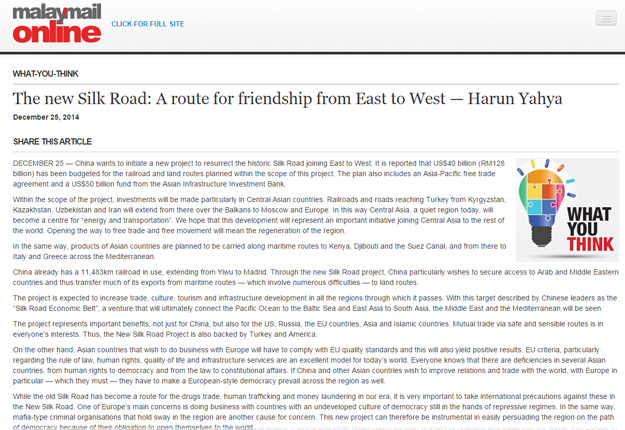
China wants to initiate a new project to resurrect the historic Silk Road joining East to West. It is reported that US$40 billion (RM128 billion) has been budgeted for the railroad and land routes planned within the scope of this project. The plan also includes an Asia-Pacific free trade agreement and a US$50 billion fund from the Asian Infrastructure Investment Bank.
Within the scope of the project, investments will be made particularly in Central Asian countries. Railroads and roads reaching Turkey from Kyrgyzstan, Kazakhstan, Uzbekistan and Iran will extend from there over the Balkans to Moscow and Europe. In this way Central Asia, a quiet region today, will become a centre for “energy and transportation”. We hope that this development will represent an important initiative joining Central Asia to the rest of the world. Opening the way to free trade and free movement will mean the regeneration of the region.
In the same way, products of Asian countries are planned to be carried along maritime routes to Kenya, Djibouti and the Suez Canal, and from there to Italy and Greece across the Mediterranean.
China already has a 11,483km railroad in use, extending from Yiwu to Madrid. Through the new Silk Road project, China particularly wishes to secure access to Arab and Middle Eastern countries and thus transfer much of its exports from maritime routes — which involve numerous difficulties — to land routes.
The project is expected to increase trade, culture, tourism and infrastructure development in all the regions through which it passes. With this target described by Chinese leaders as the “Silk Road Economic Belt”, a venture that will ultimately connect the Pacific Ocean to the Baltic Sea and East Asia to South Asia, the Middle East and the Mediterranean will be seen.
The project represents important benefits, not just for China, but also for the US, Russia, the EU countries, Asia and Islamic countries. Mutual trade via safe and sensible routes is in everyone’s interests. Thus, the New Silk Road Project is also backed by Turkey and America.
On the other hand, Asian countries that wish to do business with Europe will have to comply with EU quality standards and this will also yield positive results. EU criteria, particularly regarding the rule of law, human rights, quality of life and infrastructure services are an excellent model for today’s world. Everyone knows that there are deficiencies in several Asian countries, from human rights to democracy and from the law to constitutional affairs. If China and other Asian countries wish to improve relations and trade with the world, with Europe in particular — which they must — they have to make a European-style democracy prevail across the region as well.
While the old Silk Road has become a route for the drugs trade, human trafficking and money laundering in our era, it is very important to take international precautions against these in the New Silk Road. One of Europe’s main concerns is doing business with countries with an undeveloped culture of democracy still in the hands of repressive regimes. In the same way, mafia-type criminal organisations that hold sway in the region are another cause for concern. This new project can therefore be instrumental in easily persuading the region on the path of democracy because of their obligation to open themselves to the world.
One of the most important parts of the new project is China’s Xinjiang region. It is very important for tensions in the Xinjiang region to come to an end for China to implement the project properly. The project can also be turned into an excellent opportunity for the Uighur Turks to enjoy great benefits. The region becoming a part of the New Silk Road will mean that the Uighurs can also open up to the rest of the world.
There is also the question of the region being modernised and made more efficient in all aspects through the building of new facilities, roads and infrastructure services. There is no reason why reconciliation should not be possible between China and the Uighur Turks if they treat one another with warmth and understanding. China can eliminate tensions by allowing the Muslim people there to live by their own traditions and customs, and the people of the region can do the same by learning Chinese as an official language and by adapting to Chinese foreign policies.
Besides this, China’s adopting a European-type advanced democracy, abolishing the death penalty and adopting transparent legal norms will also ensure significant gains for the country. A China that is fully trusted by the West would make it a country of freedoms with a much better economy and greatly increased prosperity.
In conclusion
Roads have always been an important means of connecting different countries, peoples and continents. Reinstating the 2,500-year-old Silk Road, which has been instrumental in the flow of technology, knowledge and culture, is an excellent project in that regard. Indeed, the road at that time connected the civilisations of Anatolia, Rome, Egypt, China, Iran, India and Mesopotamia on its route.
It is in our power to turn the New Silk Road into a “road of friendship and love”. It is therefore most important for the states concerned to come together around such mega-projects in order for civilisations to embrace one another with love, instead of the loveless thesis of a clash of civilisations.
Adnan Oktar's piece on Malay Mail:


